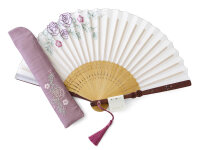
Hand Fans from Japan
Japanese Hand Fans from the Manufactory
A hand fan is an accessory used to provide pleasant cooling. The foldable hand fan is small, practical, fits in a handbag, and, especially when it comes from Japan, it is beautiful. This brings us to the second purpose of these lovely hand fans: foldable hand fans are jewelry, fashionable adornments that bestow ladies and increasingly gentlemen with a stylish aura.
The cooling effect that one can achieve with a hand fan should not be underestimated. It allows you to fan fresh air, push away warmer air from your skin, and increase the evaporation of water droplets formed on your skin. Your own well-being can be easily and elegantly enhanced with a hand fan. While hand fans were once highly exclusive accessories, today there are offerings of simple hand fans available at very affordable prices.
The History in Europe
Hand fans were already in use in Europe as early as the fourth century BC. However, their use was almost exclusively limited to ceremonies. After a long hiatus during the High Middle Ages when hand fans were virtually nonexistent in Europe, Crusaders brought them back from China and Japan in the 16th century. The popularity of hand fans then quickly reached its peak. One notable geographic center was Spain, where hand fans not only brought comfort to the aristocracy but also became an important accessory for Flamenco dancers. Simpler hand fans were imported from China, and later from Greece and Egypt. The practical foldable hand fans (folding fans) and the accompanying culture were more predominantly from Japan. This marked the beginning of a long-lasting heyday for foldable and handheld fans.
Foldable Fans - an Invention from Japan
Practical foldable fans were invented in Japan between the 6th and 9th centuries. The name of the first folding fan was Akomeogi, which was derived from a famous women's garment. Traditional foldable fans from Japan were made from strips of Hinoki, the Japanese cypress, with the number of strips varying depending on the person's rank. Today, these types of fans are almost exclusively used with formal costumes by Shinto priests and at the Japanese court. Japanese hand fans are now distinguished between Uchiwa, which are non-foldable fans (fixed fans), and Ogi or Sensu, the foldable fans. The frames of foldable fans were crafted by skilled artisans from Hinoki, later primarily from bamboo. It's evident that there are significant differences in quality that manifest in appearance, durability, and function.
For the fan coverings, paper, cotton and linen fabrics, as well as silk, are the preferred materials for hand fans. While fixed fans are typically covered with paper, higher-quality foldable wooden fans are often made with fabric. Fabrics are believed to offer a distinct quality advantage for foldable fans, as paper tends to break at the folds more easily. The price for a good-quality hand fan with a reliable folding mechanism starts at approximately 50 euros, while high-quality hand fans are priced around 100 euros. Artistic pieces made as individual creations can command prices well above 1,000 euros. High-quality fans are typically delivered with a fabric pouch or bag to protect the fan when it's not in use.
Colors and Motifs
Hand fans are an accessory for both ladies and gentlemen, and they must match the respective attire and occasion. Dominant colors include black and white, shades of blue, and shades of red, ranging from pink to deep red. Blue ranges from indigo to purple to sky blue and is often used because it symbolizes coolness. Hand fans are naturally part of elegant eveningwear, but they are also suitable for weddings, birthday parties, and any celebration. You no longer need to have an Asian appearance to proudly wave your fan at the opera. Popular motifs in Japan include cherry blossoms, dragonflies, pumpkins, and dragons, all very positive symbols that play an important role in Japanese culture. Since foldable fans are also popular gifts, they can convey heartfelt good wishes.















